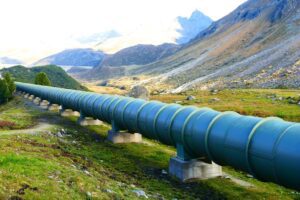First Unit at 2-GW Coal Plant in Malaysia Begins Operation. The first of two proposed 1-GW coal-fired power plants in Port Dickson, Negi Sembilan, Malaysia, began commercial operation on Aug. 22, expanding Peninsular Malaysia’s existing generation capacity to 22,748 MW. The project, which is owned and run by Tenaga Nasional Bhd (TNB) subsidiary Jimah East Power (JEP), is an ultrasupercritical (USC) plant that is “strategically located and are crucial in reinforcing the security of Peninsular Malaysia’s power supply,” said TNB. The second unit is scheduled to begin operation in December 2019. TNB also owns two other USC plants in Malaysia: Manjung 4 and Manjung 5 in Lumut, Perak. Both are among the first USC coal-fired plants in Southeast Asia, a region, which along with China and India, led an overall increase in coal-fired power generation in emerging economies in 2018. TNB owns 70% of JEP while Japan’s Mitsui & Co. Ltd. and the Chugoku Electric Power Co. Ltd. each hold 15% of JEP.
Major Southeast Asian Hydropower Plant Begins Operation. After five years of construction, the 290-MW Nam Ngiep 1 hydropower plant, which sits on the Nam Ngiep River between Lao People’s Democratic Republic and Thailand, began commercial operation on Sept. 5. The plant comprises a dam that is 167-meters (m) high and 530-m long at its crest, as well as two power plants—the 270-MW main power station, and a 20-MW re-regulation power plant. The main power plant supplies the Electricity Generating Authority of Thailand (EGAT), and the re-regulation plant supplies Electricite du Laos. Nam Ngiep 1 Power Co. is a joint venture between Japan’s Kansai Electric Power Co., EGAT International, and Lao Holding State Enterprise.
Mozambique to Get FSRU and 120-MW LNG Powership. Japanese transport company Mitsui O.S.K. Lines (MOL), one of the world’s largest shipping companies and its largest liquefied natural gas (LNG) carrier operator, and Karpowership, a subsidiary of Turkish firm Karadeniz Holding on Sept. 2 announced a joint venture, KARMOL, that will roll out a 120-MW LNG-to-powership project in Mozambique. Under the project, the companies will jointly own and operate a floating storage and regasification unit (FSRU) and a Powership—a floating power plant model Karpowership has offered since 2007. The FSRU will deliver regasified LNG and the Powership will produce power from it to Electricidade de Moçambique (EDM), the Mozambican national power utility. The companies said in March that the FSRU was being converted from an existing LNG carrier. The Powership is now already operating with heavy fuel oil in Nacala, a city on the northern coast of Mozambique, to deliver power to EDM. Once the FSRU is delivered, it will be switched to produce power with LNG. Karpowership currently operates 22 Powerships in other countries such as Indonesia, Ghana, Gambia, Sierra Leone, Lebanon, and Senegal. The fleet’s largest Powership is a massive 470-MW unit that deployed at the end of 2018 and currently provides baseload and peak power to Indonesia’s power utility PT PLN in Medan.
Giant Floating Offshore Wind Farm Takes Shape in California. Castle Wind, a company that wants to build a 1,000-MW floating offshore wind farm 30 miles offshore Pt. Estero, California, with a grid connection in Morro Bay, on Aug. 15 announced formal signing of a memorandum of understanding (MoU) with Monterey Bay Community Power, a locally established community-choice energy agency. The MoU outlines mutual interests and the intent of both parties to enter into future long-term power purchasing agreements from the project. The U.S. Bureau of Ocean Energy Management is preparing a lease auction for the project site in 2020. If awarded the lease, Castle Wind anticipates producing 1,000 MW of renewable energy around 2025. “While the project is still several years away, we know that offshore wind is poised to play an integral role in California’s electricity portfolio, which will help the state meet its aggressive climate goals at the least cost,” said Alla Weinstein, Castle Wind CEO.
Australia’s Newest Renewable Strategy Broadened to Reach Transport, Heavy Industry. The Australian Renewable Energy Agency, is an independent agency established in 2012 by the Australian government to manage the coal-rich country’s Australia’s renewable energy programs, on Sept. 11 launched a new investment plan, which it developed in consultation with industry, that sets out three new priority areas in boost Australia’s renewables supply. Under the plan, investment will be directed toward projects that support “integration of renewables in the electricity system; accelerate the development of Australia’s hydrogen industry for domestic and export; and support industry to reduce emissions.” By contrast, the agency’s last investment plan issued in 2017 prioritized delivering secure and reliable electricity, accelerating solar PV innovation, improving energy productivity, and exporting renewable energy.
Funding in more than 478 renewable projects has yielded many success stories, including “halving the cost of large-scale solar projects” through a competitive auction process. Australia also recently launched successful demand response and virtual power plant pilots; launched power projects at off-grid sites, including at energy intensive mining operations; and helped utility-scale solar and wind farms to provide their own generation forecasts, which has cut costs and improved reliability. The 2019 plan notes that the country’s shift to renewable energy is gathering momentum, and that “electricity is only one component of the energy transition.” It will focus on new approaches to system security and reliability, including grid stability services, provide enhanced flexibility through storage solutions, including pumped hydro and concentrating solar thermal, and work on new business models that improve the potential value of distributed energy resources. ■
—Sonal Patel is a POWER senior associate editor.










